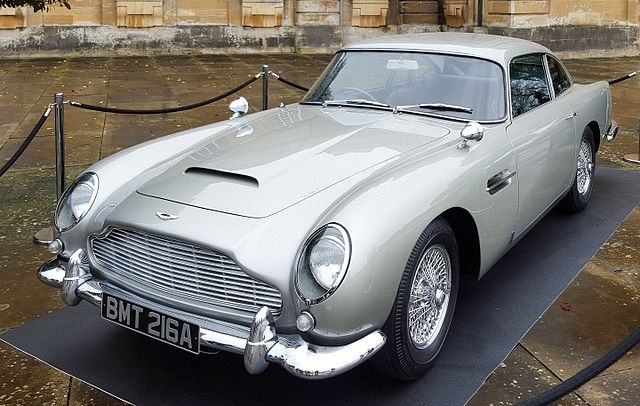
The Aston Martin DB5, produced between 1963 and 1965, represents the pinnacle of classic automotive design and performance. With its enduring appeal, this vehicle has not only become an iconic figure in the world of classic cars but has also cemented its place in popular culture.
This article delves into the essence of the DB5, exploring its history, design, performance, appearances in media, and legacy.
History and Development

The Aston Martin DB5 is a direct successor to the DB4 Series V model and was unveiled in 1963. It was designed by Carrozzeria Touring of Milan, utilizing the patented Superleggera technique that allowed for an all-aluminum body over a lightweight structure.
The DB5’s development was aimed at refining the successes of the DB4, with improvements in luxury and performance. It retained the elegant proportions and classic lines that were characteristic of Aston Martin but introduced several upgrades, including an enlarged engine and enhanced comfort features.
Production commenced in 1963 at Aston Martin’s factory in Newport Pagnell, England, and continued until 1965. During this period, approximately 1,059 units were produced, making it one of the most sought-after models by collectors. The DB5’s relatively short production run, combined with its significant improvements over the DB4, contributed to its rarity and desirability among classic car enthusiasts.
The DB5 also introduced several variants, including the convertible Volante model, the high-performance DB5 Vantage, and the limited-production DB5 Shooting Brake, a bespoke estate version. These variants catered to a broad spectrum of luxury car buyers, further solidifying the DB5’s status in the automotive world.
Design and Features

The Aston Martin DB5 is renowned for its exquisite design, combining elegance with an athletic stance. Its bodywork, characterized by smooth, flowing lines and a pronounced grille, has become synonymous with British luxury sports cars. The interior of the DB5 was equally impressive, featuring full leather trim, wool carpets, and electric windows, which were considered luxury items at the time.
The design also included reclining seats and a fire extinguisher, all standard. The attention to detail extended to the car’s instrumentation and controls, which were designed to be both functional and aesthetically pleasing. The overall design ethos of the DB5 was to offer unparalleled luxury without compromising on performance or style.
One of the key features of the DB5 was its innovative use of technology. It was one of the first cars to offer an optional factory-fitted air conditioning system, a rare luxury in the early 1960s. Additionally, the DB5 featured a state-of-the-art, for the time, electrical system that powered its sophisticated features, setting a new standard for luxury sports cars.
Performance and Engineering

At the heart of the Aston Martin DB5 was its 4.0-liter inline-six engine, which was capable of producing 282 horsepower in its standard form and up to 325 horsepower in the high-performance Vantage variant.
This powerplant was coupled with a five-speed ZF manual transmission, providing smooth and responsive gear changes. The DB5’s top speed was approximately 145 mph, with a 0 to 60 mph acceleration time of just over 8 seconds, making it one of the fastest cars of its era.
The DB5 also boasted significant advancements in handling and braking. It was equipped with servo-assisted disc brakes on all four wheels, a relatively new feature that greatly improved braking efficiency and safety. The suspension system was carefully tuned to offer a balance between sporty handling and ride comfort, enabling the DB5 to perform admirably on both the racetrack and the open road.
The engineering excellence of the DB5 was not limited to its drivetrain and mechanical components. Aston Martin also focused on the car’s aerodynamics, with the design team working meticulously to ensure that the DB5’s shape was both beautiful and functional, reducing drag and enhancing stability at high speeds.
Iconic Media Appearances
The Aston Martin DB5’s legacy was significantly bolstered by its association with James Bond, the fictional British spy created by author Ian Fleming. The DB5 made its first appearance in the 1964 film “Goldfinger,” equipped with an array of gadgets that captured the imagination of audiences worldwide.
This association with James Bond has continued for decades, making the DB5 one of the most recognizable cars in the world.
Beyond its role in the James Bond franchise, the DB5 has appeared in numerous films, television shows, and other media, further cementing its status as a cultural icon. Its elegant design and performance capabilities have made it a symbol of sophistication and adventure, appealing to a broad audience beyond automotive enthusiasts.
The enduring popularity of the Aston Martin DB5 in media has not only contributed to its legendary status but has also influenced the design and marketing of future Aston Martin models. The company has often drawn upon the DB5’s iconic image to embody the essence of the Aston Martin brand—combining luxury, performance, and timeless design.
Legacy and Collectibility
Today, the Aston Martin DB5 stands as a monument to classic automotive design and engineering. Its blend of elegance, performance, and luxury has seldom been matched, making it one of the most coveted classic cars in the world.
The rarity of the DB5, combined with its historical significance and cultural impact, has led to record-breaking auction prices, with well-preserved examples fetching millions of dollars.
The DB5’s legacy is also evident in its influence on the design and development of future Aston Martin models. Elements of the DB5’s design language and its emphasis on performance and luxury have been woven into the fabric of subsequent Aston Martin cars, ensuring that the spirit of the DB5 lives on.
For classic car collectors and enthusiasts, owning an Aston Martin DB5 is not just about possessing a piece of automotive history. It’s about connecting with an era of design and engineering excellence that has stood the test of time. The DB5 remains a timeless classic, a symbol of style and performance that continues to inspire admiration and desire across generations.
